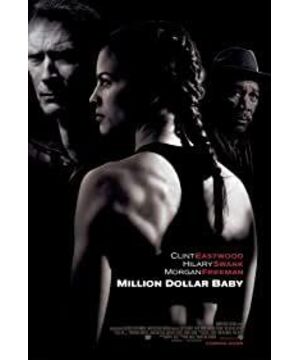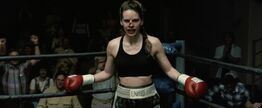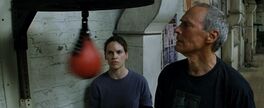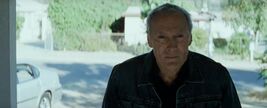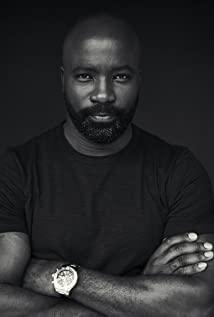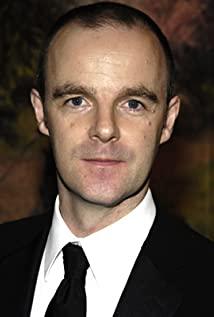As a sports film, there are many boxing matches in this film. According to Hollywood's precise expression method, each shot is adjusted according to content and expression. There are no lines in the arena situation, and the expression of good times and bad times depends entirely on audiovisual language.
1. Billy's opening game
The opening scene was a scene where Billy participated in the competition, setting the tone and style of the film for the whole film.
The 1 mirror takes a large panoramic view from the top, and the centered view of the composition is like a TV show broadcast scene, showing the environment of the game and making the audience familiar with the atmosphere. At this time, the left hand is punching, and the punching action can be seen on the camera.
2 The mirror immediately changed back to shoot Billy was beaten, and he was in a bowed posture when he was at a disadvantage. In this shot, the opponent switched to a right boxing to let the audience see the punch on the body, with the sound of a very close-to-ear punch, so that the audience could feel the strength of the boxing.
3 The mirror reacted to the audience. These crowds were sitting on their seats with drinks in an entertaining atmosphere.
4 The mirror is swayed from the soles of the feet, and from the audience's perspective, Billy is knocked down with a punch, and the narrative function is completed.
The 5 lens shows the staff and reporters, which shows that the event is grand and surrounded by the shouts of the audience. This perspective is close to the head-up of the boxing ring, showing that people outside the field care about the field, rather than shooting from the field to the outside.
Six close-up shots of Billy, exhausted Billy closed his eyes, shaking the lens violently, enhancing the sense of substitution. The composition of this shot is very tight, and Billy is in a dilemma at this time.
After the 7 mirrors are pushed apart, they surround the cross axis, enhancing their sense of movement, and the arena is changing rapidly.
After the sound of the midfield, the scene in the 8 lens is Xiaoquan, the situation is relaxed, and the composition is loose.
9 lenses use the referee's close-up shots to increase the richness of the lens language and cut scenes. This is also to introduce the stadium environment and help the audience get familiar with the sport.
10 Mirror Billy sat down, and the doctor and coach climbed up from both sides. Explain the game mechanism, and then there will be multiple shots of coaches guiding during the intermission. This descriptive shot of objective rules allows the audience to understand the basic rules.
The 11 mirrors and the narration finally let the audience notice the protagonist-Coach Deng in the middle of the screen.
Then in the conversation between the two, the front and back shots got closer and closer
Let the audience see Billy’s wound and the coach’s expression step by step
And the expression of the coach.
Panning the camera, from the medical staff to the referee, began to introduce the reactions of others to the injury.
Coach Deng needs to persuade the referee to continue the game, so here is a related shot. The characters in the relationship are no longer Billy and the coach, but the referee and the coach. So the referee in the previous shot had to look at the wound from above and behind Billy to facilitate the framing of this shot. At the same time, Coach Deng was at a disadvantage. He used the angle of overhead shots, and the characters spoke up close to the feeling of request.
The entry of the referee in the field breaks this atmosphere, shakes directly from the lens of Coach Deng, and is full of documentary dispatch.
Next, he shot Billy's reaction, and then when he countered the coach, he gave an order to Billy. At this time, he was in a strong position to face Billy, so this shot used a slightly upward perspective. In order to complete this scheduling, let the actor stand up slightly to achieve a change in the angle of the two.
After Billy got up, the camera flicked to the left and followed Coach Deng off the field. Then the camera flicked to the left, paying attention to the coach's state, and now let the audience know who is the protagonist.
Billy came on the field and the coach looked at him. After two shots, Billy's situation still did not change. So there was another shot of taking the footsteps and then looking up again. The appearance of the repetitive technique made the mood of the before and after scenes unified, Billy Still in crisis.
After a few blows, the two hugged each other, the crisis slowed down and turned into a head-up lens, shaking hands. Motion continuity editing is used here.
The audience began to have a dynamic reaction. An audience stood up. In order to distinguish from the last audience lens, explain the annular space, and increase the richness of the lens, this lens changed the direction of the audience. This time the audience shouted to the right.
The referee intervened, and the three shots.
The two separated again, and the situation became anxious. The audience has entered the arena and must give a greater visual impact.
Start using the subjective lens on the axis to face the feeling of the boxer.
Here is a detail, the coach instructed Billy to put down his fist to reveal the flaw.
Billy lowered his right fist and shook the close-up shot. In order to emphasize this moment, he upgraded to match the dynamic sound.
Back to the lens on the axis again
The fist hits Billy's wound directly, and the camera is aimed at the wound and zoomed forward. The ambient sound disappears and the sound effect is enhanced.
This shot stretched time, slower than the upgraded shot, and gave the audience time to understand the plot.
After the sound of skin and flesh, the coach is waiting for the result to appear. Stretching the rhythm can amplify the impact of the previous action.
Go back and use a relationship lens to show the coach's concern and watch the game from the coach's perspective.
When the audience is most concerned about the result, continue to suppress the result and introduce new content: a new angle appears, the camera outside the hall. The conscious movement of the camera indicates that important characters enter the venue.
Maggie appeared, moving from the dark area to the bright area, slowly appearing. It shows that the last shot is her subjective perspective. This shot of taking the character's perspective first and taking the character appears, aggravates the character's sense of existence.
Next are a few regular shots, what Maggie saw in the game and her reaction.
After returning to the arena, the heavy scene began, and Billy knocked his opponent to the ground with a final blow.
In order to strengthen this action, one action is completed with four front and back angles.
Single-action multi-camera editing, used to achieve a sense of speed.
Then use four reaction shots to achieve emotional effects.
The protagonist's reaction
Finally, I came back to the panoramic view taken from the top to finish the scene.
2. Maggie's first appearance
In this scene, Maggie played a game for the first time. At the beginning, there was no support from Coach Deng, and he played passively. Later, he had a guide to make a comeback against the opponent.
First, explain the environment. This is the first time Maggie has come to the stadium. The opening is shaken from the ceiling light. This light indicates that it is no longer in the training area, but at the same time, it also said that the stadium using this type of row of lights is only a small Arena. This lens is also a foreshadowing, which will be discussed later.
The camera pans and we see the end of a round, and Maggie walks towards her corner. The scene of Maggie's adversity was largely omitted, and he rolled directly to the place where the two were chatting, simply and neatly.
Because the content of the conversation is completely repeated with the previous game situation, you can omit one. Generally, we will omit the part of the lines for good-looking, and try to use the lens to express it, and the scene of the conversation here is obviously more necessary. The manager of the game contrasted with the professionalism of Coach Deng.
The manager’s lines were repeated twice, as an emphasis, the second time it was switched to a cross-the-shoulder shot with a relationship.
Maggie was very puzzled and observed her emotions from a close range.
From the last shot, Maggie did not directly leave the corner and enter the arena. Instead, she stood up and prepared. She stood in this position so that she could easily use the position of the camera with the relationship and give the manager an expression of indifference and disdain. Because the focus of this scene is to explain the relationship between the two. At the same time, it cuts off the continuity of Maggie's action to facilitate the omission of the next shot.
Because there is a shift in the subject at the end of the previous shot, you can omit the timeline on Maggie's side. In the next shot, Maggie is already being beaten.
Upstairs Skrepp saw all this. Explain the position of Skrep through overhead shots. We can feel that compared with Billy's game, this venue is not big, which also shows that this is a small event.
When switching the camera, avoid monotony, as Skrep swipes across the camera. Hollywood often uses such tricks, which are more attractive than standing still. The dynamic content always makes people feel "full", and the content of the lens is dizzyingly flowed. The audience will forget other things and pay attention to the movie. content. The camera pans with Skrepp, allowing the real protagonist, Coach Deng, into the shot.
It turned out that two people were watching boxing. The script may be just a sentence "Coach Deng and Skrep are watching the game from a high altitude". In fact, during the filming, the director arranged to watch it with one person first, and then reveal it to two people.
When two people were chatting, we saw their reactions.
Coach Deng talked about Maggie's flaws, and the lens gave him a subjective lens from his perspective. This is a very commonly used comment lens.
Back to the arena. Maggie was hit with two punches, and the two punches were directly hit on the head. The close-up shot of these two people was used to allow the audience to see the position of the boxing. The 2.35:1 frame ratio advantage in this shot was reflected. Wide format can better express the state of two people.
After the two chatted, Coach Deng glanced across the camera. It doesn't matter where he goes, we all know that he will enter the arena. After a meaningful space is established, the scope of other spaces does not have to be particularly clear.
The space can be omitted, and the direction can’t be random. The director uses the principle of axis to keep the unity of the characters’ direction of action. The people on the stage have been looking to the left. Qi
The seemingly simple front and back fight in the dispute between the three people is actually carefully arranged in the composition, and the picture space is balanced and comfortable, and the photographer's skills are evident.
The seemingly simple front and back fight in the dispute between the three people is actually carefully arranged in the composition, and the picture space is balanced and comfortable, and the photographer's skills are evident.
The referee enters the dialogue and shakes it with a camera that drives the momentum. In the stimulating dispute, the camera switching speeds up.
In this conversation, every time you switch the conversation lens, a different camera position is used. There are 8 camera positions in a normal conversation. A simple dialogue scene must use a lot of time and energy to keep improving during the shooting, and sometimes it has to be Admire Hollywood. This article mainly talks about martial arts, not literary drama.
After the conversation, Coach Deng went to the position where the manager should be, and kept scheduling to make the film not boring. At the same time, the swing has the effect of changing the atmosphere, which means that the new boxing chapter has begun after Coach Deng took office.
When Coach Deng started to instruct, Skrep appeared on the screen. He barely looked at the heroine, an excellent supporting role, and never robbed the scene.
Then what else did this excellent supporting role do? He swiped across the lens to help the camera move, and then went to the lower left corner to supplement the balance of the picture.
Called in the field, this is a "point" shot.
After the referee left the screen, he did not shoot the repeated boxing content, but gave the reaction of the surrounding crowd. We often think that sports movies need to continuously shoot the action details, but in fact, give a reasonable psychological effect and get a better viewing experience. The audience thinks that what they see is more important than what they actually see.
After the good show started, we already knew the surrounding environment. We didn't want to see more spatial content. We wanted to see more clearly, and the close-up lens began to be used frequently.
The heavy punch shot also uses a method of splitting the action multiple shots, the first is the accumulating shot.
The shot of punching, the same action, through continuous editing. The speed is as fast as 24 frames of motion blur, this kind of real fist and real shot effect is really good.
The next shot scheduling is very exciting and precise. After crossing the axis, first edit through the continuity of the action to maintain continuity.
Then the referee came into the scene and hinted at the result for the first time.
The camera continues to push forward, the referee draws, coach Deng and Skrep push for a close-range dialogue, suggesting the result for the second time
After two strong psychological hints, I will tell you that the opponent fell on the ground and lost miserably. Shooting down instead of a low angle, this shot means not to substitute into the opponent’s situation.
The same camera pans up and tells the viewers-now please take the psychology of Maggie!
It's over, put in the audience reaction.
Let’s cut back to Maggie, happy. These two shots were taken in one shot. They should be cut like this in the later stage. The reason is that the climax part is put together to have a better enhancement effect. Let the audience get up first and give Maggie and the coach behind. The dialogue creates an atmosphere.
Sure enough, Maggie came to talk to the coach, and the sooner the first boxing ended. We found that there are very few real action shots on the court, but when the audience first saw it, they felt that there was a big fight, on the one hand because of the details of the drama, on the other hand, because of the constant cutting in and out of the boxing ring. The lens lengthens the psychological time.
Three, Maggie's shooting method for easily defeating the opponent in the game
Maggie is a talented person. What is a talent is easy to learn. At the beginning, he learns very quickly.
1 The mirror opens with a close-up lens. The audience is already familiar with the ringtones on the ring, and they can transition through the iconic details.
The 2-lens telephoto lens compresses the space, and the boxing ring still looks very small. The right fist facing the camera strikes.
Switching to a large space, facing the camera with a left fist attacking, for the first time the knock down effect in the same scene appeared. Generally, the action under the panoramic view did not seem to be strong enough. In order to increase this intensity, let the actor fall on the fence first. Fall to the ground to lengthen the effect of this action. Three shots ended a game.
Ring the bell again, and a new game begins. Note that the camera positions of the same camera have changed twice, and they did not be lazy to shoot twice in the same camera position.
In order to distinguish it from the previous shooting method of the game, this lens was directly panned up, and the loose lens soothed the feeling. It can be seen that this game was played very easily, the lens was not edited, and the time was very short.
Following a looser shot, Maggie came out in a new outfit, and the opponent entered the picture from a humble corner.
More relaxed counterattack
I even used a jump cut to quickly edit the reactions of the characters.
Coach Deng took a chair for her on the court. The matter of holding a chair is also a foreshadowing, and there are very interesting applications in the back shots.
Maggie leaves the screen, the opponent is lying on the ground, the game is over, the whole game in the movie takes 10 seconds, 6 shots. The director only let the audience see that Maggie knocked down the opponent, and it was done.
After a play in the rest room, the four rounds of the game continued. With a higher-angle wide-angle overhead shot, the venue seems to be bigger than last time, and the number of spectators is also larger, standing in the foreground.
This section uses cross-axis shooting, the chaotic sense of the cross-axis plus the shaking of the close-up, fast switching
Before figuring out what was going on, the opponent fell to the ground. The four shots were 2 seconds long, and each shot took less than 0.5 seconds.
After falling to the ground, the camera directly shakes up, because we already know that the opponent can't get up, so shake the camera up to see Maggie's reaction in the background.
Then came the reaction of the coach surrounded by the audience. In this shot, the audience behind is wearing orange clothes for the first time, allowing you to see the jumping audience.
Maggie and the coach shrugged, and the communication time between the two was longer than the time of the game.
The whole scene ended with the coach's response.
3. Maggie's not easy game
Several fast games in a row require a slow-paced respite, and then a long-lasting game will be arranged.
It still started from pulling the bell, this time we saw the person pulling the bell.
The same camera bell rang up, and the two continued to play for a while.
Changing the angle, we saw for the first time the angle of view of the boxing ring.
I changed two angles and played for a while, and the scene did not change. When the audience was a little impatient, the coach came out to adjust. In this segment, I switched several times between shooting the coach and shooting the close shots of the two. The narrator told us that this was not an easy game. Compared to standing and watching the game, the director arranges for the coach to walk around the sidelines, which is more consistent with the editing of the on-field sports footage.
This decisive punch was shot directly with a close-up lens, which aggravated the feeling of being thrown out. I have to say that the supporting role is very dedicated and needs to jump up to perform and be beaten up.
After the end, in the scene where the coach and Maggie handed each other's eyes, Maggie kept jumping, shaking violently while holding the camera, which could make the scene look very hot.
The whole game ended with two people celebrating in the same frame. The movement of celebration in this movie is also progressive. This is the first celebration. The two people just shake hands, then hug, and then Maggie jumps up with her legs crossed on the coach. This kind of detail is very interesting.
Fourth, Maggie is injured
The crisis is coming.
The new game starts, this time roll over from the right side to see the panoramic view of the field.
The upgraded game uses a stable telephoto lens at a high altitude, which looks more formal.
In the next close-up shot, the opponent's key punch was thrown out to match the sound of broken bones inside.
Maggie fell out of the picture.
When cutting back again, Maggie hugged her opponent.
Take a picture of the coach first, and then take a picture of the facts he saw.
Maggie's face was bloody, and after a shot, we learned that the coach knew she was injured, ah, damn montage charm.
At the end of the round, the coach put a chair close-up. Become a sign of communication between the two.
In the next scene, the coach treated Maggie's interrupted nose, constantly raising the round signs and referees to increase the sense of tension, and returning to the arena after a short period of hemostasis.
We saw the referee preparing to start, this is Maggie’s perspective after the injury
Then hit Maggie's side. Say with two shots: "Come on, the show has begun."
The middle shot fisted and blocked, and then switched to the close shot to continue.
The off-court coach is watching the game anxiously. This is a slightly overhead shot, which makes us feel that the coach is still a little worried.
When I cut back to the field, the game became more intense and the editing speed accelerated. These few punches and Maggie succeeded. There is no special secret. It is still an application for pros and cons. As long as it is used well, the pros and cons can be played extremely well. Great power.
Maggie's last punch was brought down by a shot, first hitting the head, then shaking it down to watch the opponent fall to the ground, inserting the coach's reaction in the middle of the editing, but also to increase the sense of rhythm.
There was an audience member who stood up to a higher level, and this time many audience members were jumping up and cheering.
While the audience cheered, Maggie returned to the corner. The middle shot was to keep Maggie in the environment and in the cheers of the crowd.
From Maggie's perspective, overhead shots of opponents who can't stand up are shots that despise opponents. This is very interesting. If I pat the opponent’s reaction against the ground, I will let the audience bring in the person who was down. I feel sorry for the opponent. Look up a digression. For example, in "Joker Joker", the shot of the clown raising the billboard and being beaten is low. Angle shot clown.
To make sure that the opponent has failed, when shooting Maggie again, let us pay more attention to Maggie's mood after victory, and adopt a close-up shot of Maggie that strips away the environment characters.
The coach also used a closer scene, he uttered the classic Gaulish.
This battle ended in a hug between the two. For the first time in the movie, there was a hug between the two. Turning defeat into victory always seemed more exciting than winning the game. Through this moment, the relationship between the two becomes closer, making the embrace reasonable and advancing the plot.
V. Progressive Maggie
There is contrast to make progress. The opening shots used repeated ceiling shakes. Normally, this kind of repetition is avoided, but the requirement of the narrative here is to evoke our memory of Maggie's first participation in the competition.
This camera panned down and hit the forehead with a punch,
Then from another angle, Maggie directly knocked down the opponent.
This time, I didn’t split an action into the shot. The focus here is no longer the punch, but Maggie’s quick and easy fight. In the next shot, she stands firmly in the shot, panning from the close to the middle. It is left for the audience to cheer, and the cheering time is longer than the time of the game.
At the beginning of a new match, the fence of the boxing ring became a visual guide line. She stood at the top of the triangle formed by the fence, as if unbeatable.
Then the camera backs away, and Maggie draws, we hear the sound, boxing is outside the screen, how do we know the situation of the game, through the coach's reaction, he does not even need to put down the stool, this is one of my favorite shots.
The camera was pushed back again, Maggie returned to the screen, the background audience began to cheer, a shot of a boxing match. If this lens is used alone, it is too bloody, but it is used here, there is a foreshadowing of the previous game, and the strength here is just right to make your blood boil.
After that, Maggie will enter Europe, and when she comes back, she will start her career peak. The audience shouted her Gaul, the highlight moments in several games of this film. Then there will be her Waterloo, and in the second half of the game the drama is more dramatic.
It is too hard to write this stuff. If anyone likes it, I will analyze it in the next article.
View more about
Million Dollar Baby reviews


